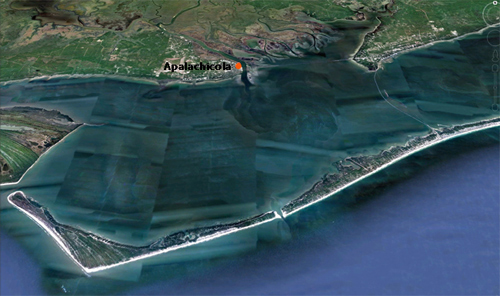
by Rick O'Connor | Sep 23, 2016
Humans have been settling on, and around, coastal estuaries since they first arrived in the panhandle over 10,000 years ago. These bodies of water have provided food and recreation as long as anyone can remember. They are a magnet for those looking to build homes or businesses – and we continue to be attracted to them today.
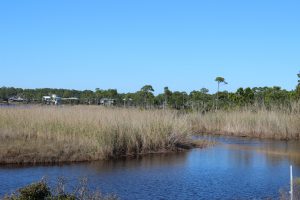
Black Needlerush is one of the species of marsh grasses that live in brackish conditions.
Estuaries are defined as semi-enclosed bodies of water where fresh and sea water mix. The point where the freshwater enters is called the head of the bay; the point where seawater enters is called the mouth. Seawater is denser than freshwater so during incoming tides the saline water tends to “wedge” it’s way into the upper estuary along the bottom. Under certain conditions, it is possible to catch freshwater fish near the surface and marine species on the bottom at the same location. The mixture of fresh and seawater makes for an interesting cocktail of salinities termed brackish water – which is required for the development of almost 90% of the commercially valuable seafood species we enjoy. This ecosystem supports stands of vegetation which are also important in the development of some species – some of these systems are the most biologically productive on the planet.
We are lucky to have several large estuaries along the Florida panhandle. All of our bays are what are called drowned river valleys. Most are very wide and pretty shallow, with the highest average depth being 17 feet in Choctawhatchee Bay. The rivers that feed these estuaries begin in states north of us and bring with them needed freshwater and nutrients. Each of the panhandle estuaries is unique and provides different resources for their neighboring communities. Below is a breakdown of some of these characteristics. This information was provided by GulfBase.org.
| Bay |
Surface Area (km2) |
Drainage Area (km2) |
Avg. Daily Inflow (m3/sec) |
Avg. Depth (m) |
Avg. Salinity (ppt) |
Area of Wetlands (km2) |
Area of Submerged Vegetation (km2) |
| Perdido |
130 |
3,100 |
62 |
3.0 |
15 |
688 |
ND |
| Pensacola |
370 |
18,100 |
328 |
4.0 |
23 |
991 |
32 |
| Choctawhatchee |
334 |
14,000 |
241 |
5.0 |
25 |
1,133 |
12 |
| St. Andrews |
243 |
2,800 |
127 |
4.0 |
31 |
1,016 |
53 |
| St. Joseph ND |
|
|
|
|
|
|
|
| Apalachicola |
554 |
53,100 |
824 |
3.0 |
22 |
2,396 |
36 |
| Apalachee |
412 |
11,900 |
150 |
3.0 |
30 |
2,813 |
130 |
You can see some of our estuaries have large areas and tremendous amounts of freshwater inflow. Others not so much, the bays with less freshwater inflow have higher salinities – and support a different ecology than the others. Is one better than the other?… no… certainly our ancestors understood this. Higher salinities meant more seagrass, scallops, and urchins – certain species of fish and maybe even marine turtles could be found here. Lower salinities meant a different group of fish, oysters, and crabs. It’s all good! Residents should benefit from what the bay provides – and not try to make “your bay” more like “another bay”.
They have suffered some over the years – discharge containing organic and inorganic chemicals have tainted some drinking water supplies as well as reduce valuable aquatic resources. Increased sediments from development have darkened the waters reducing light and reducing submerged plants. Heavily fishing and recreation have impacted both the habitats and the species that inhabit them. Through the efforts of universities, government agencies, non-profit organizations, and private citizens many of the problems have been addressed – and recovery is occurring… but there is still more to do.
National Estuaries Week is a chance for all who live in the panhandle to realize how important these bodies of water are to our locally economy and to our quality of life. We hope you will appreciate them and do your part to help protect them. HAPPY NATIONAL ESTUARIES WEEK!
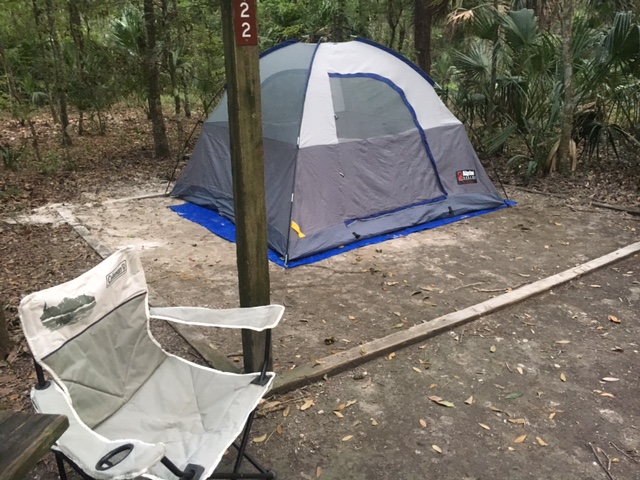
by Rick O'Connor | Sep 16, 2016
This past week I was camping at a state park near Gainesville. Working on a variety of computer related items while sitting in my chair, I was acutely attuned to the sounds of life around me. A small “pat-pat-pat” could be heard in the leaf litter around the tent. Curious as to what was making the sound, I moved the leaves until numerous small frogs showed themselves – and immediately settled on my tent. The wind rustling through the trees, the distinct “kee kee kee” of the red shouldered hawk, and the sounds of numerous woodland song birds filled the senses and all caused me to pause my work and listen to life.
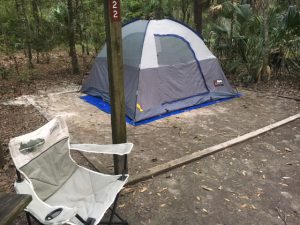
Camping is a great way to clear the mind, think through problems, and experience the natural world.
Photo: RIck O’Connor
The evenings were no different… the loud rustling of digging armadillos, the distinct calls of at least two types of owls, and the howling of coyotes could be heard every night. Then one evening…nothing… it all stopped. I heard no owls, coyotes, or frogs. The woods had become completely silent. Funny how you notice silence as much as you do the “calls of the wild”.
The following morning the skies were different. They were not dark but you could sense rain was in the area. I moved into the tent in time for the rain to begin…a light rain, but rain none the less. And it rained all day… and most of the night. I was dry within my tent – continued to work on my computer – but was aware of the extent of the rain and of the silence around me. It was not until later that evening that I heard there was a tropical system on the Atlantic coast. The woods had become silent the afternoon before…did they know it was coming?
Camping does this… it reconnects us to the natural world. We can experience Florida the way our ancestors would have. To listen to the animal sounds, sense the changes in the weather, and explore. Yes, explore. You can only sit at the campsite for so long. Most campgrounds provide hiking trails and swimming areas where you can not only explore nature but get much needed exercise. Some campgrounds provide elevated observation towers with benches where you can sit, listen, look, and let the hub-bub of typical daily life escape you for a while. Honestly… here I get some of my best ideas for work. I think clearer and can prioritize a hectic schedule of “to-do’s”. I recommend bringing a small notebook to jot down ideas as they come. It is very relaxing and productive at the same time.
If you have kids… perfect! There are fewer “wild areas” within neighborhoods for kids to explore their natural world. Many youth today have not experienced finding hermit crabs or frogs. Camping is a great way for them to do this. I understand that some are nervous about different forms of wildlife while camping (snakes) but honestly, I rarely see them. They have learned to stay clear of open areas – I have bigger problems with squirrels and ants. Do not let that stop you from enjoying Florida.
There are several state parks with camp grounds in the Florida Panhandle; Torreya State Park even has a couple of yurts! You may need to reserve a site. There are campgrounds scattered in the Apalachicola National Forest, which are less visited. If you are in the Escambia / Santa Rosa area – you can visit Naturally EscaRosa.com to find camping options in that area.
So let’s chill a bit… and go camping!
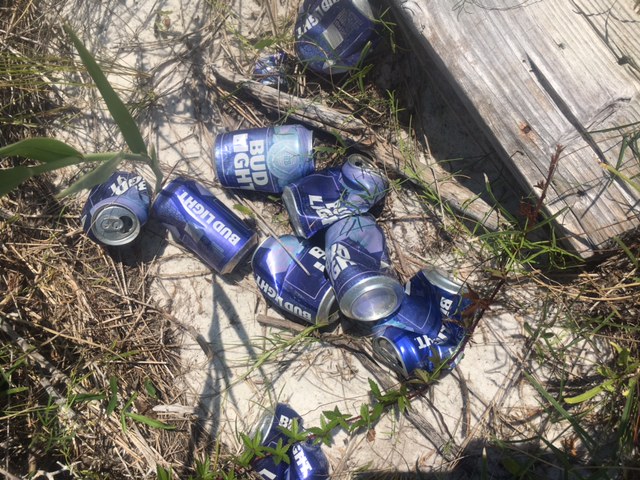
by Rick O'Connor | Sep 2, 2016
People have been trying to do something about marine debris, and solid waste in general, since we saw the commercial of the crying Indian in the early ‘70’s. Have we made any improvement?
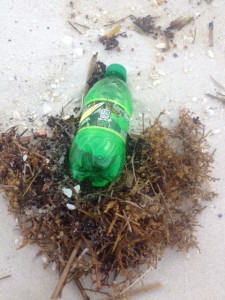
A variety of plastics ends up in the Gulf. Each is a potential problem for marine life. Photo: Rick O’Connor
Yes… but there are still problems to deal with.
Literally millions of tons of solid waste are produced and disposed of each year. According to the 16th edition of Living in the Environment by G. Tyler Miller and Scott Spoolman (2011), Americans generate 2.5 million tons of solid waste each year. This total could fill enough garbage trucks to circle the earth 8 times – bumper to bumper. Though we only make up 4.6% of the world’s population we generate 33% of world’s solid waste. Scientists have been recommending that we reduce the amount of solid waste we produce for some time… but we are not.
So what are we going to do about the problem?
Well, if you are not going to reduce the amount generated you have basically three choices
- Bury it
- Burn it
- Recycle it
Currently Americans are burying about 54% of their solid waste, 25% is recycled, 14% is incinerated, 7% is composted. Comparing our recycling efforts to other nations we are not doing too bad, but there is room for improvement – there is actually a need to improve. The majority of the solid waste we throw away actually ends up in the environment. It has been determined that 80% of the plastics in the ocean come from land – and much of this was thrown in the trash by people who were doing the right thing.
To reduce waste, we need to know what it is we are throwing away. According to Miller and Spoolman the top five items we throw away are:
- Paper/cardboard – 37%
- Yard waste – 12%
- Food – 11%
- Plastics – 11%
- Metal – 8%
Most of these can be recycled or composted – should be easy – but we are not doing it as often as we should.
What about local marine debris?
I have been working with the local group OCEAN HOUR. Ocean Hour cleans a shoreline somewhere in the Escambia / Santa Rosa area every weekend (check out their Facebook page or the Escambia County Extension website to know where). Volunteers come out to help remove the waste and Ocean Hour provides buckets, tongs, and gloves for them to do so. Sea Grant, Escambia County, and students from local schools help to gather data from what they are collecting.
| TOP FIVE ITEMS |
2015 |
2016
|
| 1 |
Cigarette butts |
Cigarette butts
|
| 2 |
Food wrappers |
Foam
|
| 3 |
Plastic bottles |
Plastic bottles
|
| 4 |
Plastic pieces |
Glass bottles
|
| 5 |
Foam |
Food wrappers
|
Plastics
There has been a lot of concern about plastics in the environment. Paper, food, and yard waste are oxygen demanding waste, and need to be reduced, but their life span in the ocean is much shorter than plastic. Plastics are made using large polymers produced while refining oil and natural gas. There are about 46 different types and many products are a mix of different polymers. This actually makes some forms difficult, and costly, to recycle. Most counties can recycle #1 and #2 forms of plastic. Water bottles are made from a form of plastic called polyethylene terephthalate (PET). These are easier and less costly to recycle than some other forms but they must be disposed of separately. One PVC bottle in a truck load of plastic water bottles will keep the entire truck load from being recycled.
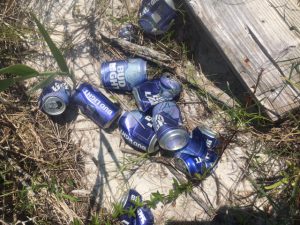
Another issue, which you will be hearing more about this month, are microplastics. Much of the plastic that reaches the ocean will break down due the sun and the ocean elements. These bring on their own problems – read more about microplastics on this website or the link above.
We certainly encourage all folks who live in the panhandle, or who are visiting, to reduce the amount of solid waste they generate – recycle or compost what you can – and participate in community cleans ups – such as those put on by Ocean Hour. The International Coastal Clean Up will be September 17. Check the Escambia County website for locations. We can do this!
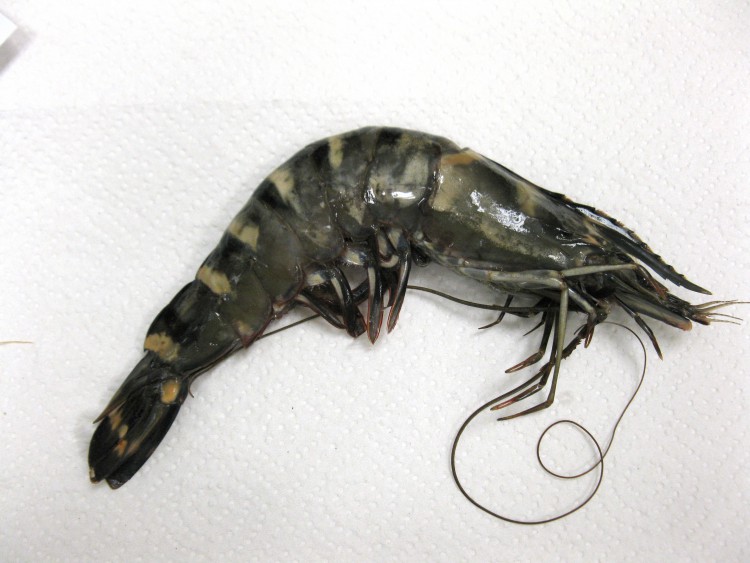
by Rick O'Connor | Sep 2, 2016
The Asian Tiger Shrimp (Penaeus monodon) have been reported across the northern Gulf of Mexico for several years now but unlike Cogon grass, Chinese tallow, and Lionfish they have not really made the press. We know they are there, but captures in shrimp trawls seem to be infrequent… it just does not look like a serious problem.
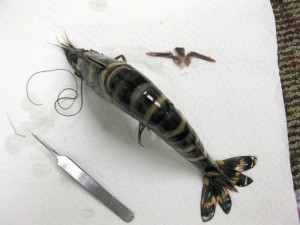
The Asian Tiger Shrimp can reach lengths of 12″
But now there is a study being conducted by Dr. Jennifer Hill (Louisiana Tech University) that sheds a little light on the impacts of this new invasive species. Working out of Dauphin Island Sea Lab, and funded by Mississippi-Alabama Sea Grant, her study is looking at the interactions between the tiger shrimp and our native species – the white and brown shrimp.
Tiger Shrimp as Predators
Dr. Hill has discovered that tiger shrimp do not prefer salt marshes, as our native species do. They are apparently too large, ranging between 8 and 10 inches – some as large as 14 inches, and prefer more open environments. Tiger shrimp may prefer seagrass beds, another haunt for local shrimp, but she is not sure at the moment. She has noticed that when tiger shrimp are around the native shrimp move towards structure. This is to avoid predation by tiger shrimp, which do try and catch them – but they are not very good at it. Her study indicates that 80-90% of the native shrimp survive such attacks, but forcing the natives towards structure could impact the catch by our shrimpers.
Tiger Shrimp as Prey
Preferring open environments leaves tiger shrimp at a higher risk of predation. One thought is that their large size and dark color may not be recognized as a shrimp by local predators. One species that has shown interest in them are redfish. Dr. Hill has found that redfish will not hesitate to go after them, and may actually prefer them over white shrimp, but – because of the size of the tiger shrimp – it must be a large redfish.
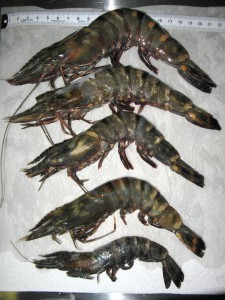
Five tiger shrimp captured by shrimpers in Pensacola Bay.
Shrimpers in Alabama and Mississippi are currently selling the tiger shrimp they capture to Dr. Hill for her studies. She found that very few were captured in 2014, possibly due to the cold winter that year, but had plenty submitted in 2015. The mild winter of 2016 may produce a large number this summer. If you are shrimper in the Pensacola area, and interested in selling live tiger shrimp at $30 each, contact Dr. Hill at (251) 861-2141 ext. 2179.
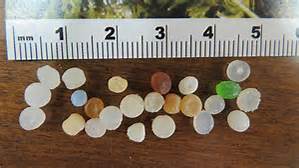
by Rick O'Connor | Sep 2, 2016
Going along with the International Coastal Clean Up, UF/IFAS Extension will be promoting September as Microplastics Awareness month.
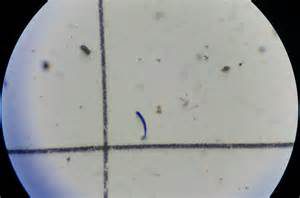
The most common form of microplastic are fibers.
Photo: UF IFAS St. johns County
If you have not heard, microplastics are small pieces of plastic < 5mm in diameter. Some are fragments from larger pieces of plastic that have been broken down by the elements, others are produced at that size to be used in products such as stuffed animals or melted in molds to produce larger products. Some microplastics are small beads used in cosmetics, but the most common are fibers from our linens and clothing. These fibers are removed during washing and travel through the drain and sewer systems until the reach the sea. Either way – they end up in our coastal waterways where they have had some negative impacts on marine life.
Some impacts include:
- Consumption by plankton give the sensation of being full – thus they stop eating.
- A decrease in the reproductive success of oysters.
- Negative impacts on hatching rates and activity rates of some species of larval fish, making them more prone to predation.
- They have also been found to be more common in sea salt and have been found in the guts of some fish and bivalves sold at seafood markets on the west coast. We are not sure of the impact of human consumption of these products.
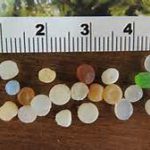
Small microbeads called “nurdles” are used to fill stuffed animals and to make larger plastic products.
Photo: UF IFAS St. Johns County
During the month of September, we will be posting short articles on our Facebook pages and on Panhandle Outdoors. Extension will also host a webinar on the topic September 16. It will be broadcast from 12:15 to 1:00 PM EDT. To register for this webinar go to https://www.eventbrite.com/e/whats-the-big-deal-with-microplastics-webinar-tickets-27070847634. Please like and share these with your friends so that we can make more people aware of this problem. If you would like to have a public presentation on microplastics, contact your county Extension office. Check in on these posts throughout the month.
http://facebook.com/NEFLSeaGrant
https://www.facebook.com/MicroplasticAwarenessProject
www.plasticaware.org













